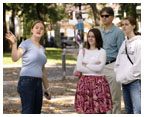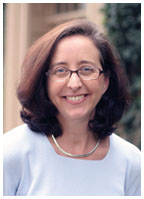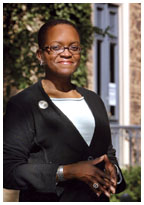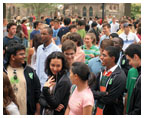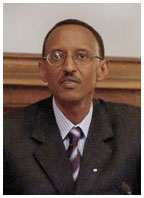
|
October 11, 2006: Notebook
Princeton to eliminate early-decision program
Rapelye: ‘A deeper and broader applicant pool’
Sarah Paine ’08, left, leads an Orange Key campus tour for prospective applicants and their families last month. (Frank Wojciechowski) |
Princeton to eliminate early-decision program
Princeton will move to a single admission deadline for applicants next year, eliminating the early-decision program used to select nearly half the freshman class each year. The single deadline first takes effect for students applying to enter Princeton in September 2008.
“We are making this change because we believe it is the right thing to do,” President Tilghman said, adding that a unified admission process would encourage “an even broader pool of excellent students” to apply.
The Sept. 18 announcement, greeted by applause at the first faculty meeting of the academic year, came just a week after Harvard announced that it would end its early-admission program next year because it “advantages the advantaged.”
Princeton officials agreed with that view. Janet Rapelye, dean of admission, said that students from low-income families and from minority backgrounds are “much less likely” to submit early-decision applications.
An additional factor, Tilghman said, was the belief that eliminating early admission can reduce some of the “frenzy” of the admission process for students and their families. Both Princeton and Harvard said they hoped that other universities would take similar action.
While Harvard’s early-action program does not require admitted students to enroll at the college, Prince-ton’s early-decision plan is binding. Applicants who submit applications by Nov. 1 receive a decision by mid-December.
Rapelye said Princeton “is in the strongest possible position” to make a change, noting that the admission office had to choose among a record 17,564 applicants this year and that only 10.2 percent were offered admission. “If we don’t take this step, nobody else can,” she said.
Princeton’s use of early decision has substantially improved its yield of admitted students who choose to enroll. In 1994, the year before Princeton adopted early decision, the University enrolled 57 percent of its admitted students. The yield for the Class of 2010 is 68.8 percent, and it has been as high as 73.6 percent.
Yield is one factor in national rankings like those offered by U.S. News & World Report, which has rated Princeton No. 1 for several years. Princeton officials said it was possible that the change would affect the University’s position in the rankings.
Initial reaction was mixed. Princetonians for the Preservation of Early Decision, a student group formed on the Web site Facebook.com, quickly attracted nearly 100 supporters. “Princeton’s applicant pool will quickly regress from students who truly appreciate the school’s extraordinary opportunities to those who are simply looking for a prestigious name on their diplomas,” the group’s founders said.
Marta Richards ’73, a longtime alumni schools volunteer in Louisiana, wrote in The Daily Princetonian that ending early decision “merely disadvantages the early commits; it does nothing to spread the word to the disadvantaged.”
But Elizabeth Duffy ’88, headmaster of the Lawrenceville School, praised the University’s action as “one step toward bringing a little bit more sanity to an admission process that has spun out of control.” Nicholas Allard ’74, the former chairman of the Princeton Schools Committee, said the 6,000 ASC volunteers will be “even more important” not only in interviewing applicants, but in encouraging “Princeton-caliber students with yes letters from multiple top schools” to decide to enroll at Princeton.
Rapelye said Princeton was able to move so quickly after Harvard did because Princeton had been reviewing the admission process each summer and “had the research ready.” In addition, the Board of Trustees was scheduled to meet Sept. 1416. The trustees “enthusiastically” supported the decision, said Stephen Oxman ’67, chairman of the board’s executive committee. While Harvard said it would review its decision after a trial period of two to three years, Princeton added no such condition to its action.
Rapelye said she hoped to allay the fears of critics: “I am quite convinced
that we will be able to enroll the very best class for Princeton, and
send a message to the outside world that we care about equity and fairness.”
![]()
By W.R.O.

Janet Rapelye (Denise Applewhite/Office of Communications) |
Rapelye: ‘A deeper and broader applicant pool’
Two days after Princeton announced that it would eliminate its early-decision admission program, Dean of Admission Janet Rapelye met with PAW’s managing editor, Ray Ollwerther ’71, to discuss the impact of the change:
Will this affect the recruiting of athletes?
We want the very best scholar-athletes to come to Princeton and not go to our competitors. The vehicle we’ve been using for many years is the “likely letter” [written notification of the probability of admission]; it’s an Ivy League agreement that we share. ... I want to make sure that [coaches] understand that this was a decision that was right for the University and that we want to do everything we can to support the coaches in their recruitment efforts. The advantage is that we have a whole year to plan for this.
[Coaches are concerned] that the students don’t have to make a commitment to us [on the early-decision timeframe]. And so even with a likely letter, they could still get a call from another coach at another school who perhaps could persuade them to turn their head. And I think that’s the worry — but I have great confidence in our coaches that they will continue to make this appealing place an appealing offer to that student.
Are likely letters also sent to students who are not athletes?
Because we have been using early decision, we had not been using likely letters in that form in the past. But it’s very possible we’ll consider that seriously as we move forward. ... Likely letters could be used for many reasons you want a student to think seriously about Princeton University — a great violinist, [or] a particular talent in the creative arts. What we want to avoid is sending as many likely letters as early-decision letters — then we’ve defeated the whole purpose.
How will applicants be able to communicate that their first-choice college is Princeton — and is that important?
I imagine there will be students who will tell us that Princeton is their first choice. The question, does it make a difference, is a good one, because in our pool with so many thousands of fabulous students, I’m not sure it’s ever made that much difference. ... What we’re trying to do is build the very best class for Princeton, and my hope is that when students get to Princeton, they are able to solidify those strong ties and that loyalty to this place.
Do you expect the makeup of the class to change?
If we are able to build a deeper and broader applicant pool in terms of students from a wider range of socioeconomic backgrounds, students with more racial and ethnic diversity, we will be able to choose a more multicultural class. And that’s an important value to the University.
What about legacy admissions?
We are still very committed to the children of our graduates. We’ve been admitting the children of our graduates at three times the rate of everyone else, and I anticipate that to be the same — I don’t see a change there. It’s not a formula; it’s not a quota; that number goes up and down depending on the quality of the pool each year. ... When I look at the statistics of the children of our graduates, they are as strong as the rest of the class. So I can stand up and say, we’re making the right decision for Princeton.
What’s likely to happen to Princeton’s yield of admitted students?
When we look at regular decision, the yield has been somewhere around the 50 percent mark. So this decision is going to mean that our yield will change, and it is unlikely that our yield will be at the 69 to 71 percent mark again. But the yield in and of itself does not indicate quality of intellect; it only has indicated selectivity, and it’s only been a measure thrust upon us by outside organizations. ... We are going to be able to attract a very strong and powerful applicant pool, and we are going to be able to admit superb classes.
The new class of freshmen is the most diverse in Princeton’s history; doesn’t this show that the present system is working?
Only a very small proportion of our minority students were applying early decision; only a very small proportion of students who needed financial aid were applying for early decision. It doesn’t mean that’s how we were choosing them; it’s how they were applying to us. They weren’t even in the running.
Is Princeton taking a risk in making this move?
Yes! But the choice is to take complete competitive advantage of this [Harvard’s
decision on early admission] and ignore the fact that we are not providing
an opportunity for students from low-income backgrounds to be part of
a process, or to say we really care about every student having the same
chance of being admitted, and we will put competitive advantage aside
for the moment. Because competitive advantage in this case feels selfish,
and that’s not as educators what we’re trying to do. ![]()
MORE
ON THE WEB: An extended interview with Dean Rapelye, click here.

Professor Valerie Smith, director of the Center for African American Studies, outside Stanhope Hall, the center’s future home. (Frank Wojciechowski) |
A
stronger role for African-American studies
The new center will add faculty, expects to offer a major within
five years
Hoping to become “the leading voice” in the study of race in America, Princeton has launched a Center for African American Studies that will double the size of the African-American studies faculty, provide more course offerings, and ultimately offer a major in the field.
“Of all the challenges that confront America, none is more profound than the struggle to achieve racial equality and understand the impact of race on the life and institutions of the United States,” President Tilghman said in a statement. Unless the University enhances its program, she said, “We will be unable to attract or retain the brilliant scholars who are making and remaking this important field.”
The initiative follows recommendations from an advisory committee, headed by philosophy professor Kwame Anthony Appiah, which had been looking into the future of Princeton’s Program in African-American Studies since the fall of 2005. Appiah, the Laurance S. Rockefeller University Professor of Philosophy and the University Center for Human Values, said the new center “could have a big impact, not just on graduate and undergraduate education here, but also the shape of the field.”
The center will be housed in the heart of the campus, in historic Stanhope Hall, which is being renovated. Valerie Smith, a professor of English who directed the Program in African-American Studies, will continue as director of the center.
As a center, African-American studies at Princeton will have considerably more strength. It will be able to make appointments solely in African-American studies, as a department can do, instead of having to rely on departments to make joint appointments. The number of full-time-equivalent faculty positions will be increased from five to 11 — so the center could have as many as 22 faculty members if all the appointments are split with departments. The timing for hiring faculty members depends largely on fundraising for the center, according to University spokeswoman Cass Cliatt ’96.
Tilghman said that the University will aim to offer a major in African-American studies within five years, noting that there must first be enough faculty to support a major (all the Ivies except Princeton already offer an African-American studies major). A program for visiting research fellows will bring scholars from around the world, and an existing graduate seminar will expand to a yearlong course.
African-American studies will continue to have a distinctly interdisciplinary approach. “We’re building on Princeton’s strength of a core faculty that recognizes that you can’t do jazz studies now without taking on board the work of African-American cultural studies, and you can’t study politics or public policy, or even bioethics, without work that has been done in areas of race,” Appiah said.
Religion professor Eddie S. Glaude Jr. *97, who served on the advisory committee, described Princeton’s plan as “providing a blueprint for African-American studies in the 21st century.” In its early days, he said, black studies programs were intended largely to diversify the faculty and student bodies and to quiet student rebellions; its practitioners sought work that was practical and immediately relevant.
Today, younger scholars have built a rich bibliography and are “engaged in a vibrant intellectual conversation” about issues such as the importance of the African diaspora, challenging the assumptions of their predecessors, Glaude said.
Princeton’s African-American studies program already has a star-studded faculty that includes Appiah, Smith, and Cornel West *80, as well as highly respected junior professors. However, Tilghman noted that the University is weak in some areas, such as African-American studies faculty in politics and public policy, and has “always struggled to maintain critical mass” in the faculty.
West and Appiah both arrived in 2002 from the celebrated black studies
program built at Harvard by cultural scholar Henry Louis Gates Jr. At
the time, Gates openly discussed coming to Princeton as well, but decided
to remain at Harvard. Cliatt would not comment on whether Gates might
now want to join the center, saying that “we haven’t identified any individual
faculty members.” ![]()
By M.M.

Members of the Class of 2010 gather at the University Chapel for Opening Exercises Sept. 10. (Denise Applewhite/Office of Communications)
The Class of 2010 Students: 1,231 Applicants: 17,564 Students admitted: 10.2% Students on financial aid: 55% Students admitted by early decision: 49% Men: 53% Women: 47% States represented: 47 (plus Washington, D.C.) Countries represented: 42 U.S. minority students: 37% Varsity athletic prospects: 17.6% Sons/daughters of alumni 13.9% International students: 10.3% Entering graduate students Doctoral-degree students: 422 Master’s-degree students: 158 Applicants: 8,641 Students admitted: 13% Men: 61% Women: 39% International students: 39% U.S. minority students: 14% Humanities and social sciences: 50% Sciences and engineering: 45% Architecture: 5% Sources: Office of Admission; Office of the Dean of the Graduate School. Figures are for the preregistration period. |
Opening Exercises celebrated a theme of global connections as Princeton welcomed the largest and most diverse freshman class in University history.
“It is no exaggeration to say that the world has come to Princeton, helping all of us to become true cosmopolitans,” President Tilghman said during her address to the Class of 2010 in the University Chapel. Urging students to seek out those with differing viewpoints, she said diversity is essential to intellectual and personal growth and is “fundamental to a Princeton education.”
The class set records for the number of students from minority backgrounds (456, or 37 percent) and for the number of international students (128, from 42 countries). With 1,231 students, the class is also Princeton’s largest, as the University gradually increases the size of the undergraduate student body through the year 2012.
Following the convocation in the Chapel, the students participated in the third annual Pre-rade, marching in through the FitzRandolph Gate to the cheers of several hundred upperclassmn and the sounds of the University Band. They received T-shirts that read “Jersey Frosh” on the back and “Approved by West College” on the front before heading to a welcome barbecue in front of Blair Hall.
“I like the symbolism of walking in through the gates you are not going to walk out of until graduation,” said Miguel Sansalone ’10 of Oklahoma City. “Everyone was so spirited.”
Marta Tienda, professor of sociology and public affairs, expanded on the theme of embracing diversity during the freshman assembly at McCarter Theatre. “Let us return to the democratic, demographic ideals of our founding fathers who emphasized inclusiveness and belonging,” she said, drawing on her own research in the field of immigration. “We need to build bridges, not fences.”
During the week leading up to Opening Exercises, more than 700 freshmen
took part in programs designed to build teamwork among the new classmates.
Outdoor Action attracted 610 freshmen to 68 different trips in seven states,
while 120 students participated in 12 Community Action projects in Philadelphia,
Trenton, and Princeton. The service projects included building construction,
working in shelters and soup kitchens, and helping with children’s programs.
![]()
By Adam Gottesfeld ’07

Paul Kagame (Sherry Zhang ’09/the Daily Princetonian) |
“We believe that we have to change Rwandan politics. It is fundamentally clear from our history that exclusionist perspectives only led our country into devastation. Our political value system is sustained by a commitment to power-sharing.”
Paul Kagame, president of Rwanda and founder of the Rwandan Patriotic
Front, speaking Sept. 21 in McCosh 50 on “Post-Conflict Reconstruction
and Development in Africa: The Rwandan Experience.”
![]()

Lisa Curran *94 Terence Tao *96 (Photos courtesy Macarthur Foundation) |
Graduate alumni Lisa Curran *94 and Terence Tao *96 were among the 25 MACARTHUR FELLOWS for 2006, announced Sept. 19. Curran, a tropical biologist, earned her Ph.D. in ecology and evolutionary biology at Princeton. Now a professor at Yale, she has conducted innovative field research in the forests of Indonesia. Tao, a professor at UCLA who studies complex mathematics, received a Fields Medal less than a month before being awarded the MacArthur “genius” grant. MacArthur Fellowships recognize “exceptional creativity, as demonstrated through a track record of significant achievement, and manifest promise for important future advances.” Each fellow receives a five-year grant worth $500,000.
The University’s efforts to curb GRADE INFLATION have led to a decrease in the number of A grades in undergraduate courses, and the change has had “no discernable negative effect” on the job prospects or graduate school admissions of Princeton students, Dean of the College Nancy Malkiel said at the Sept. 18 faculty meeting. According to statistics released by the Faculty Committee on Grading, 41 percent of course grades were A’s in 200405 and 200506, compared with 47 percent in the two years preceding the new grading policy. The policy aims to reduce the percentage of A’s to 35. In the past two years A’s accounted for 46.4 percent of all grades in the humanities, 42.7 percent in engineering, 37.9 percent in social sciences, and 35.8 percent in natural sciences. In the job market, the percentage of graduates who left campus with full-time jobs increased in each of the last two years, and Princeton applicants also enjoyed a higher rate of acceptance to medical and law schools.
The Alumni Association’s FALL FOOTBALL LECTURE SERIES will kick off Oct. 21 before the Princeton-Harvard game with Professor Natasha Lee’s talk about identity and difference in the French enlightenment. Brandice Canes-Wrone ’93, an associate professor of politics and public affairs, will discuss presidential politics and public opinion Nov. 4 before the Penn game, and astrophysics professor David Spergel ’82 will answer the question, “Is the universe shaped like a football?” Nov. 18 before the Tigers’ season finale against Dartmouth. The hour-long lectures begin at 10 a.m. in Dodds Auditorium, Robertson Hall.
When the International Astronomical Union announced in August that Pluto
would be classified as a “dwarf planet,” it also determined the fate of
2003 UB313, an object discovered last year by astronomer MICHAEL
BROWN ’87 and two colleagues. UB313, officially named Eris in
September, is slightly larger than Pluto and much farther away from the
sun. It joined the former ninth planet and the asteroid Ceres in the “dwarf-planet”
category. Brown, a professor of planetary astronomy at Caltech, said he
was disappointed that Eris wouldn’t become the 10th planet, but added:
“I definitely support the IAU in this difficult and courageous decision.
It is scientifically the right thing to do, and is a great step forward
in astronomy.” ![]()

Edward Stiefel, the Ralph W. Dornte Lecturer with the rank of professor,
died Sept. 4 in New Brunswick, N.J., at age 64. Stiefel joined the chemistry
department in 2001 after 21 years as a scientist for ExxonMobil, where
his work included the environmental remediation that followed the 1989
Exxon Valdez oil spill in Alaska. At Princeton, he helped to advance the
University’s bio-solar hydrogen program, taught a popular graduate-level
course on metals in biology, and led a freshman seminar that explored
chemistry’s role in the evolution and diversity of life. ![]()

